Remember when the United States was such an industrial powerhouse that corporations in other countries outsourced their work to us? Neither do I, but apparently that was the case after World War II, when many American factories had a surplus capacity while Europe and Asia were still rebuilding.
This 10.5-minute video shows the Talgo train under construction at ACF’s Berwick, Pennsylvania factory.
In 1949–the same year Budd introduced the RDC–American Car & Foundry (ACF) fulfilled a contract to build three Talgo trains, including three locomotives and 32 cars, for the Spanish government-owned railroad. Talgo stands for “Tren Articulado Ligero Goicoechea Oriol” which means “lightweight, articulated train by Goicoechea and Oriol,” the latter two being the company founders.
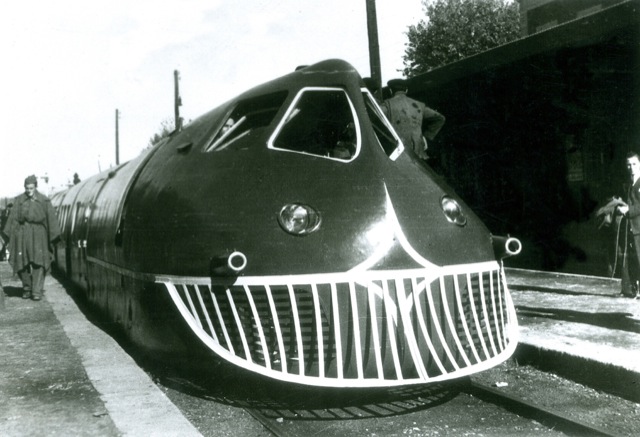
The first Talgo train was built in Spain in 1942. Note that it is not much taller than the man walking next to it. Click image for a larger view.
Talgo trains are characterized by having cars that are short in both length and height; most cars being supported by two wheels at one end of each car, with the other end resting on the adjacent car; and all pulled by locomotives that are, shall we say, peculiar-looking. Today’s Talgo trains are also noted for their pendulum tilting, but it didn’t build its first tilting cars until 1980.
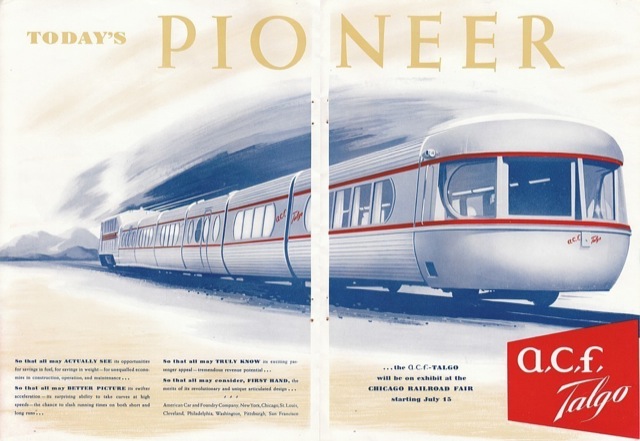
This ACF advertisement announced that the Talgo train would be on display at the Chicago Railroad Fair after July 15, 1949. Click image for a larger view.
ACF, no doubt still stinging from losing its position as the nation’s number two passenger rail car builder to the Budd Company more than a decade before, was happy to build the trains. Though shorter, the rail cars were four inches wider than American cars because Spanish tracks are 9.5-inches wider than American.
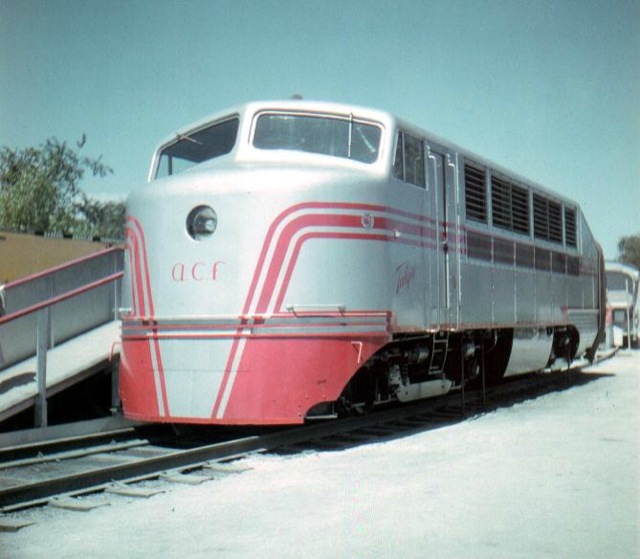
The ACF Talgo locomotive on display at the Chicago Rail Fair.
Two of the new trains were immediately shipped to Spain, but ACF displayed one at the 1949 Chicago Rail Fair and used it for a few demonstration trips on the New Haven and New York Central railroads. Life magazine called the train “bizarre,” but reporters marveled at the fact that interior floors were 33 inches lower than in a conventional train.
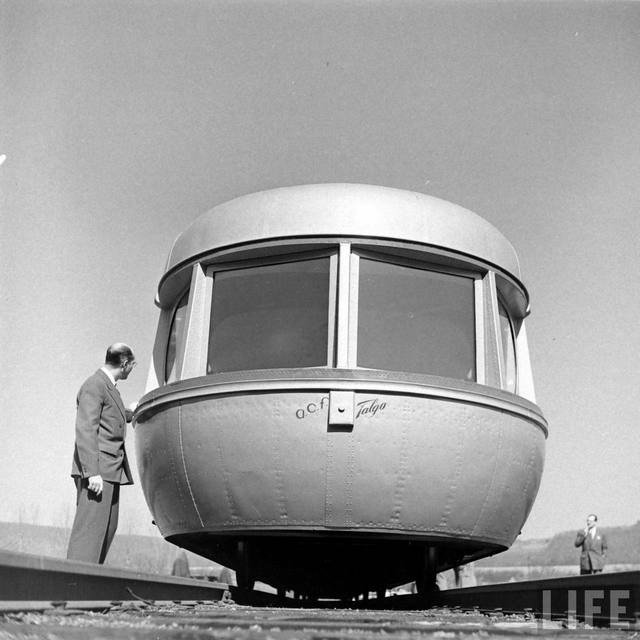
Taken by Life magazine photographer Al Fenn, this photo used in the April 25, 1949 issue of Life, but the man on the left was airbrushed out. Click image to download a PDF of the two-page spread from Life featuring the Talgo train.
Despite the publicity, no American railroad expressed interest in Talgo-type trains for several years. As passenger revenues declined, however, rail executives interested in cutting costs eventually tried several experiments with super-lightweight trains.
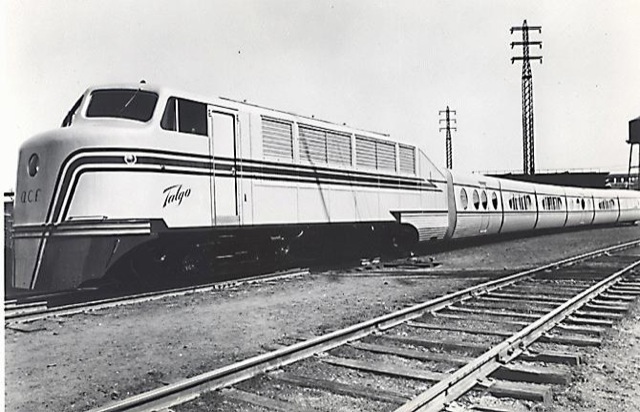
This photo showing the diminutive train was used in a two-page spread in the June, 1949 issue of Popular Science magazine. Click image to download a PDF of the article.
Spain was very happy with the trains and continued running them until 1972. One is preserved and on display in a museum about 25 miles south of Barcelona. You can see some photos of the museum, including three of the Talgo train including interiors at this blog.
Spain’s Francisco Franco personally attended the inaugural run of the Talgo trains on March 2, 1950.
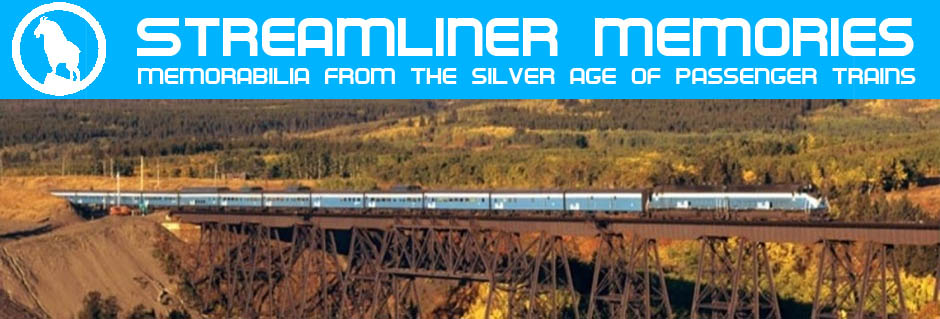
I wondered how these trains built for wider 5 foot, 6 inch Spanish tracks could run on U.S. of A. standard gauge 4 foot, 8-1/2 inch tracks, but a link to a Popular Science article mentions that they were intended for through service between Madrid, Spain, and Paris, France (France uses standard gauge tracks), so they had to be able to run on both gauges, just as modern Spanish Talgo trains for through international service do.
The Talgo II set tested in the USA (of which there are numerous photos) apparently had running gear adjusted to standard gauge (not really “wheelsets”) – as far as I know three trainsets in total were built, all are preserved in Spain today (two at rail museums and one at a Talgo factory).
They had four types of cars: Luggage van, passenger car (four rows of four seats), “door car” (with entrance doors, toilets, galleys, air conditioners for four passenger cars and some space for baggage/wardrobe) and end observation car. These operated with a class 350 locomotive also built by acf, the consists were unidirectional and could only be backed slowly through triangles to reverse them at end stations.
The gauge changing mechanism was only introduced 1969 with the Talgo III RD which operated to France and Switzerland. The Talgo II required some rebuilding in a workshop to operate on spanish gauge.
The Talgo I was, by the way, the curious looking dark train built out of steel in Spanish factories, using a motor bogie of a Ganz diesel railcar. Though I know of no colour photos, according to Talgo employees it was painted blue. The whole trainset (which had quite an inventive-looking rear end car) went up on fire after years of being stored at a Talgo factory.
The Spanish have shown their ability to build supremely ugly vehicles with everything from naval vessels to the early Talgo trains. Why ACF ever had the idea the Talgo could be a widespread success here is beyond me. Regardless of the technical merits of the concept, the very low door heights meant the trains couldn’t be loaded from standard height platforms. Ground level platforms weren’t a problem, but high level platforms were another matter. In Spain, the railroads were government owned. Once Franco decided that the Talgo was the train of the future, most station platforms were rebuilt to accommodate the lower height. That wasn’t the case in the USA. Once of the “solutions” offered by ACF was for the first car to have a standard height door, with passengers marching up and down steps to reach or detrain from the rest of the cars. One can only imagine the kind of bottleneck created if the train was carrying any kind of load.
I rode a Talgo from Madrid to Paris sometime in the late 80’s. The train was reasonably comfortable and stable, although traveling at 150 mph at a height not much higher than an ordinary passenger car was a bit disconcerting. There was a half-hour stop at the border used for customs, and workmen adjusted the truck gauge from the side of the train using some kind of hydraulic jack arrangement. It looked like it took about a minute per axle with a a crew of two men. The time consumer was swapping out the locomotive, since adjusting track gauge on power trucks was a much more difficult operation. My understanding is the Spanish have now perfected a means of using electric motors, pulling power from the onboard generators, to adjust the locomotive track gauge at the flick of a switch. This obviates the need to change out locomotives at the border.
Jim
I’m not aware of any platform rebuilding for the Talgo II in Spain. As far as I know they only had low platforms anyway and a train of low floor height made it easier to board. In the USA (at least in the east) high platforms are common, so rolling stock must be built to match that.
I also rode a Talgo from Montpellier to Barcelona in the 1980s. Gauge changing is mechanical and automatic, and does not include the locomotive which is uncoupled before the procedure and moved to the rear end, pushing the trainset through the gauge conversion facility at slow speed without stopping.
Meanwhile the same mechanical gauge changing (no switch flicking) has been implemented on power units of class 130, 730 (operated as “Alvia” by renfe). But these only operate within Spain. As the “elipsos” overnight trains from Spain to Paris, Zürich and Milano have been cancelled, what remains are standard gauge TGV into Spain via the new high speed standard gauge connection. As far as I know the gauge changer of Port Bou (if it still exists) sits unused.